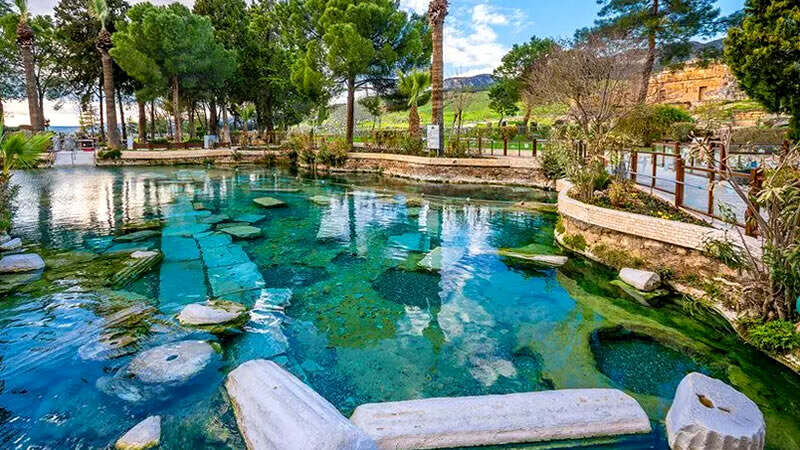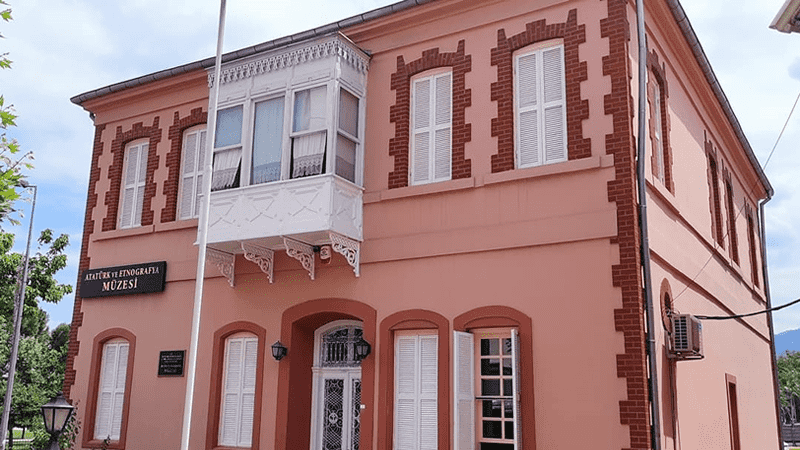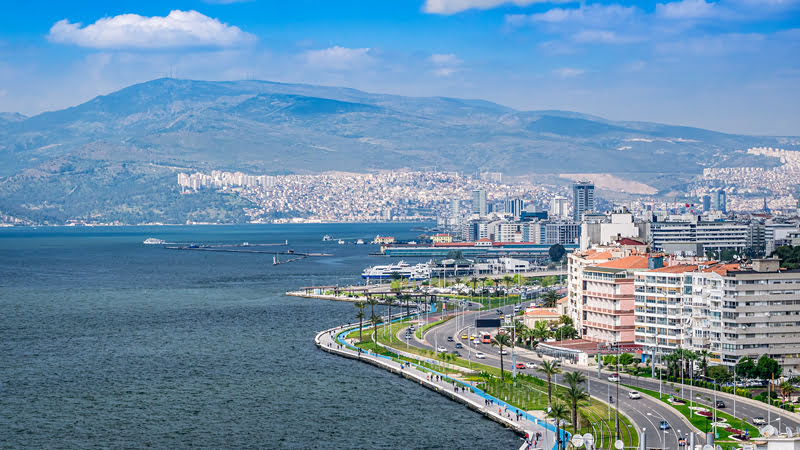Laodicea Ancient City - A Journey from Antiquity to Modern Times

Located near Pamukkale in the Denizli province of western Türkiye, the ancient city of Laodicea is a unique cultural heritage site that bears the deep marks of history. Known especially for its Hellenistic and Roman period remains, this ancient city attracts history enthusiasts and tourists alike. Laodicea holds significance not only for its historical structures and archaeological wealth but also as a center of trade, culture, and religion throughout history. This article explores the history, architecture, and cultural importance of the Laodicea Ancient City and serves as a guide for visitors to discover this fascinating place.
Laodicea was founded in the 3rd century BCE by Seleucid King Antiochus II, named in honor of his wife Laodice. Due to its strategic location, the city rapidly expanded, becoming one of the most important trade centers in the region within a short time. Laodicea became especially famous for textile products, wool, and cotton trade. This commercial wealth transformed it not only economically but also into a significant cultural and religious hub. Numerous temples, theaters, baths, and other public structures were constructed in Laodicea, many of which still stand today as indicators of the city's prosperity and social life.
During the Roman Empire, Laodicea gained further prominence, particularly as one of the seven churches mentioned in the letters of Saint Paul, one of Jesus' apostles, making it sacred in Christian history. The city reached its peak economically and religiously during this period. However, a massive earthquake in 60 CE caused significant damage to Laodicea. Although the city was rebuilt with the support of Emperor Nero, it gradually declined and was eventually abandoned.
Laodicea offers visitors architectural structures and ruins that reveal the splendor of ancient times and the details of daily life. Despite being built thousands of years ago, the structures in this historical city, part of Denizli province, serve as an open-air museum today. Visitors to Laodicea feel the deep traces of history with every step, gaining a unique experience of ancient social, commercial, and religious life.
The two large theaters in the Laodicea Ancient City are among the most important parts of the city’s architectural heritage. In ancient times, theaters were not only venues for entertainment and performances but also centers of social and political events. The Hellenistic and Roman theaters in Laodicea reflect the architectural and cultural characteristics of the time while shedding light on the city’s social structure.
Hellenistic Theater: Built in the 3rd century BCE, it has a smaller and simpler design. This theater, with typical features of ancient Greek architecture, was used for smaller-scale events and local performances. Its simple, functional design reflects the modest lifestyle and aesthetic sense of that period. The seating steps bring the audience closer to the stage, creating a more intimate atmosphere.
Roman Theater: Built in the 1st century CE under the influence of the Roman Empire, this theater is larger, more elaborate, and grand. The detailed decorations, reliefs, and expansive stage area showcase the wealth and splendor of the Roman era. With its large capacity, this theater hosted large-scale events, official ceremonies, and gladiator fights. The intricate reliefs and sculptures in the stage building exhibit the fine craftsmanship of Roman art, giving visitors a glimpse into the aesthetic sense of the ancient period.
The agoras in the Laodicea Ancient City were the heart of the city’s commercial life. An agora was a large open area in Greek and Roman cities where social, commercial, and political activities took place. The existence of multiple agoras in Laodicea underscores the city’s commercial importance and economic vibrancy. These large squares served as meeting points for social and commercial activities and operated as marketplaces and trade centers.
The colonnaded galleries in the agoras were used as spaces for merchants and artisans to display their products. The columns reveal the elegance and durability of Roman architecture. These columns and ruins, still standing today, allow visitors to feel the liveliness of ancient commercial life. Additionally, the agora was a space where public opinions were discussed, and citizens gathered for social interaction.
The stadium in Laodicea was constructed as a large venue for sports competitions and gladiatorial fights in ancient times. During the Roman Empire, this stadium became the center of the city's entertainment and sports life, hosting major competitions and events like gladiator fights. The oval structure of the stadium combines the functional and aesthetic features of Roman architecture.
The seating areas were designed to accommodate thousands of spectators, reflecting the concept of mass entertainment in ancient times. Visitors exploring the stadium can gain significant insights into the sports and entertainment culture of that era. The central arena, where gladiators fought and competitions were held, carries traces of history, and the events held here attracted great interest as a reflection of the city’s social and cultural structure.
The nymphaeum in Laodicea is an impressive structure that met the city’s water needs and demonstrated the success of Roman architecture in water engineering. Nymphaea were typically constructed as temples dedicated to water deities and served as monumental water distribution points. The nymphaeum in Laodicea, located at a major intersection of the city’s water routes, served both as a religious and social center in ancient times.
The ornate facades and water pools of this structure highlight the importance and sacredness of water in the Roman era. Additionally, the Laodicea nymphaeum served as the center of the city’s water distribution system. Through this structure, clean water was supplied to various parts of Laodicea, preserving the city’s water infrastructure. Visitors wandering among the magnificent remains of the nymphaeum have the opportunity to closely observe ancient water engineering and architecture.
One of the most notable ruins in the Laodicea Ancient City is its churches. Laodicea was a city of great importance in Christian history. These churches are structures that exhibit the architectural features of the early Christian period. Particularly the church dating back to the 4th century CE and mentioned in Saint Paul's letters reflects the city’s religious identity and significance in Christian history.
The churches in Laodicea exhibit the classical features of Roman architecture, with columned galleries and spacious interiors. These churches played a major role in the spread of Christianity in the city and the shaping of the community's religious identity. Visitors exploring these churches can observe architectural details of the early Christian period and traces of religious rituals. Additionally, the ornate mosaics and frescoes in the churches showcase some of the finest examples of religious art from that period.
Laodicea Ancient City not only offers historical and cultural riches to visitors but also presents an opportunity to discover the natural beauty of the region. Pamukkale, located near the ancient city, is famous for its natural travertine terraces and is a must-see after visiting Laodicea. Additionally, the nearby Hierapolis Ancient City, with its ancient theater, necropolis, and other structures, is worth a visit.
The best times to visit Laodicea are in spring and fall when the weather is suitable for exploring the ancient city comfortably. In summer, temperatures can be quite high, so it is recommended to visit early in the day. Be sure to allocate at least 3-4 hours to explore the Laodicea Ancient City thoroughly, as its vast area and rich ruins require time for an in-depth exploration.
Transportation to Laodicea is very easy from the Denizli city center. By renting a car in Denizli, you can explore the area comfortably and visit not only Laodicea but also other nearby tourist spots. Reliable companies like iZMiRCAR offer visitors a comfortable travel experience.
Laodicea Ancient City is not just a tourist attraction but also holds significant importance in terms of world cultural heritage. Therefore, preservation and restoration efforts in the ancient city are carried out meticulously. Recent archaeological excavations have uncovered many previously unknown structures in Laodicea, providing more insights into the city's history. The mosaics, sculptures, and other artifacts discovered during these excavations once again showcase the cultural richness of Laodicea.
Laodicea Ancient City, bearing deep traces of history, is a heritage site of great cultural and religious significance. With its rich history, impressive architecture, and preserved ruins, it offers visitors a unique experience. Visiting Laodicea is not only about exploring an ancient city but also embarking on a journey through the dusty pages of history. By visiting this captivating ancient city, you can feel the splendor of the past and enjoy discovering a cultural heritage that spans from ancient times to the modern era.
When you find yourself in Denizli, dedicate a day to visiting this fascinating ancient city and explore the area by renting a car. A trip with iZMiRCAR will provide you with a comfortable experience, making your journey into the history of Laodicea even more unforgettable.
The History of Laodicea
Laodicea was founded in the 3rd century BCE by Seleucid King Antiochus II, named in honor of his wife Laodice. Due to its strategic location, the city rapidly expanded, becoming one of the most important trade centers in the region within a short time. Laodicea became especially famous for textile products, wool, and cotton trade. This commercial wealth transformed it not only economically but also into a significant cultural and religious hub. Numerous temples, theaters, baths, and other public structures were constructed in Laodicea, many of which still stand today as indicators of the city's prosperity and social life.
During the Roman Empire, Laodicea gained further prominence, particularly as one of the seven churches mentioned in the letters of Saint Paul, one of Jesus' apostles, making it sacred in Christian history. The city reached its peak economically and religiously during this period. However, a massive earthquake in 60 CE caused significant damage to Laodicea. Although the city was rebuilt with the support of Emperor Nero, it gradually declined and was eventually abandoned.
Architecture and Remains of Laodicea: Glorious Traces of the Ancient Period
Laodicea offers visitors architectural structures and ruins that reveal the splendor of ancient times and the details of daily life. Despite being built thousands of years ago, the structures in this historical city, part of Denizli province, serve as an open-air museum today. Visitors to Laodicea feel the deep traces of history with every step, gaining a unique experience of ancient social, commercial, and religious life.
Theaters: Heart of Cultural and Social Life
The two large theaters in the Laodicea Ancient City are among the most important parts of the city’s architectural heritage. In ancient times, theaters were not only venues for entertainment and performances but also centers of social and political events. The Hellenistic and Roman theaters in Laodicea reflect the architectural and cultural characteristics of the time while shedding light on the city’s social structure.
Hellenistic Theater: Built in the 3rd century BCE, it has a smaller and simpler design. This theater, with typical features of ancient Greek architecture, was used for smaller-scale events and local performances. Its simple, functional design reflects the modest lifestyle and aesthetic sense of that period. The seating steps bring the audience closer to the stage, creating a more intimate atmosphere.
Roman Theater: Built in the 1st century CE under the influence of the Roman Empire, this theater is larger, more elaborate, and grand. The detailed decorations, reliefs, and expansive stage area showcase the wealth and splendor of the Roman era. With its large capacity, this theater hosted large-scale events, official ceremonies, and gladiator fights. The intricate reliefs and sculptures in the stage building exhibit the fine craftsmanship of Roman art, giving visitors a glimpse into the aesthetic sense of the ancient period.
Agora: Center of Trade and Social Life
The agoras in the Laodicea Ancient City were the heart of the city’s commercial life. An agora was a large open area in Greek and Roman cities where social, commercial, and political activities took place. The existence of multiple agoras in Laodicea underscores the city’s commercial importance and economic vibrancy. These large squares served as meeting points for social and commercial activities and operated as marketplaces and trade centers.
The colonnaded galleries in the agoras were used as spaces for merchants and artisans to display their products. The columns reveal the elegance and durability of Roman architecture. These columns and ruins, still standing today, allow visitors to feel the liveliness of ancient commercial life. Additionally, the agora was a space where public opinions were discussed, and citizens gathered for social interaction.
Stadium: Center of Sports and Entertainment
The stadium in Laodicea was constructed as a large venue for sports competitions and gladiatorial fights in ancient times. During the Roman Empire, this stadium became the center of the city's entertainment and sports life, hosting major competitions and events like gladiator fights. The oval structure of the stadium combines the functional and aesthetic features of Roman architecture.
The seating areas were designed to accommodate thousands of spectators, reflecting the concept of mass entertainment in ancient times. Visitors exploring the stadium can gain significant insights into the sports and entertainment culture of that era. The central arena, where gladiators fought and competitions were held, carries traces of history, and the events held here attracted great interest as a reflection of the city’s social and cultural structure.
Nymphaeum (Ancient Fountain): Center for Water Distribution
The nymphaeum in Laodicea is an impressive structure that met the city’s water needs and demonstrated the success of Roman architecture in water engineering. Nymphaea were typically constructed as temples dedicated to water deities and served as monumental water distribution points. The nymphaeum in Laodicea, located at a major intersection of the city’s water routes, served both as a religious and social center in ancient times.
The ornate facades and water pools of this structure highlight the importance and sacredness of water in the Roman era. Additionally, the Laodicea nymphaeum served as the center of the city’s water distribution system. Through this structure, clean water was supplied to various parts of Laodicea, preserving the city’s water infrastructure. Visitors wandering among the magnificent remains of the nymphaeum have the opportunity to closely observe ancient water engineering and architecture.
Churches: Witnesses of the Early Christian Period
One of the most notable ruins in the Laodicea Ancient City is its churches. Laodicea was a city of great importance in Christian history. These churches are structures that exhibit the architectural features of the early Christian period. Particularly the church dating back to the 4th century CE and mentioned in Saint Paul's letters reflects the city’s religious identity and significance in Christian history.
The churches in Laodicea exhibit the classical features of Roman architecture, with columned galleries and spacious interiors. These churches played a major role in the spread of Christianity in the city and the shaping of the community's religious identity. Visitors exploring these churches can observe architectural details of the early Christian period and traces of religious rituals. Additionally, the ornate mosaics and frescoes in the churches showcase some of the finest examples of religious art from that period.
Places to Visit in Laodicea and Recommendations
Laodicea Ancient City not only offers historical and cultural riches to visitors but also presents an opportunity to discover the natural beauty of the region. Pamukkale, located near the ancient city, is famous for its natural travertine terraces and is a must-see after visiting Laodicea. Additionally, the nearby Hierapolis Ancient City, with its ancient theater, necropolis, and other structures, is worth a visit.
The best times to visit Laodicea are in spring and fall when the weather is suitable for exploring the ancient city comfortably. In summer, temperatures can be quite high, so it is recommended to visit early in the day. Be sure to allocate at least 3-4 hours to explore the Laodicea Ancient City thoroughly, as its vast area and rich ruins require time for an in-depth exploration.
Transportation to Laodicea is very easy from the Denizli city center. By renting a car in Denizli, you can explore the area comfortably and visit not only Laodicea but also other nearby tourist spots. Reliable companies like iZMiRCAR offer visitors a comfortable travel experience.
Significance and Conservation Efforts of Laodicea
Laodicea Ancient City is not just a tourist attraction but also holds significant importance in terms of world cultural heritage. Therefore, preservation and restoration efforts in the ancient city are carried out meticulously. Recent archaeological excavations have uncovered many previously unknown structures in Laodicea, providing more insights into the city's history. The mosaics, sculptures, and other artifacts discovered during these excavations once again showcase the cultural richness of Laodicea.
Laodicea Ancient City, bearing deep traces of history, is a heritage site of great cultural and religious significance. With its rich history, impressive architecture, and preserved ruins, it offers visitors a unique experience. Visiting Laodicea is not only about exploring an ancient city but also embarking on a journey through the dusty pages of history. By visiting this captivating ancient city, you can feel the splendor of the past and enjoy discovering a cultural heritage that spans from ancient times to the modern era.
When you find yourself in Denizli, dedicate a day to visiting this fascinating ancient city and explore the area by renting a car. A trip with iZMiRCAR will provide you with a comfortable experience, making your journey into the history of Laodicea even more unforgettable.
















































